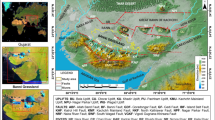Abstract
The synanthropic vegetation in seven villages of Northern Greece (N Pindhos and Olympus massif)—situated either in theQuercion confertae or in theFagetalia zone—is analyzed on the basis of about 100 phytosociological relevés. The most important vascular plant species of ruderal sites have also been mapped floristically. Nineteen plant communities are discernible, some of which are mentioned for the first time here. Nevertheless, the author refrains from hastily describing new associations, unless a more detailed phytosociological data basis on ruderal vegetation in the Southern Balkans is available.
A table refers to differences and similarities between the recognized plant communities in Greek villages and those which correspond to them in Central Europe. Non-industrial methods of agriculture and animal husbandry are among the most important conditions for the remarkable rich vegetation in Greek mountain villages.
Similar content being viewed by others
Literatur
Akeroyd J. R. (1986):Chenopodium L.—In:Strid A. (ed.): Mountain Flora of reece. 79–82.—Cambridge.
Athanasiadis N. (1975): Zur postglazialen Vegetationsentwicklung von Litochoro Katerinis und Pertouli Trikalon (Griechenland).—Flora 164: 99–132.
Baltisberger M. etLenherr A. (1984): Labiaten aus Albanien.—Candollea 39: 423–439.
Bergmeier E. (1983): Bemerkungen zum Rückgang der Dorfflora am Beispiel der Gemeinde Kalletal (Kr. Lippe)—Natur und Landschaft 58(9): 330–332.
Bergmeier E. (1988):Artemisietea-Gesellschaften in Bergdörfern Nordgriechenlands und Beobachtungen zur Apophytisierung.—Ms. [Vortrag b. 31. Inter. Symp. Inter. Verein. Vegetationskunde, Frascati, 11.–15. 4. 1988.]
Beuermann A. (1956): Typen ländlicher Siedlungen in Griechenland.—Petermann's Geogr. Mitt. 100: 278–285.
Brandes D. (1981): Ruderal- und Saumgesellschaften des Etschtals zwischen Bozen und Rovereto.—Tuexenia 1: 99–138.
Brandes D. (1982): DasSambucetum ebuli Felf. 1942 im südlichen Mitteleuropa und seine geographische Gliederung.—Tuexenia 2: 47–60.
Brandes D. (1983): DasHeracleo-Sambucetum ebuli in West- und Mitteleuropa.—Collq. Phytosoc. 12: 591–596.
Brandes D. (1985a): Nitrophile Saumgesellschaften in alten Parkanlagen und ihre Bedeutung für den Naturschutz.—Phytocoenologia 13(3): 451–462.
Brandes D. (1985b): Die spontane Vegetation toskanischer Städte.—Tuexenia 5: 113–125.
Brandes D. (1987): Zur Kenntnis der Ruderalvegetation des Alpensüdrandes.—Tuexenia 7: 121–138.
Braun-Blanquet J. (1964): Pflanzensoziologie, 3. Aufl.—Wien/New York.
Brullo S. etMarceno C. (1983): Contributo alla conoscenza della vegetazione nitrofila della Sicilia.—Colloq. Phytosoc. 12: 23–148.
Drossos E. G. (1977): Beitrag zur Kenntnis der PflanzengesellschaftAtropetum belladonnae im griechischen Raum. (griech.)—Diss. Thessaloniki.
Eliáš P. (1980): Ruderálne spoločenstvá obce Diaková pri Martine.—Zpr. Čs. Bot. Společ., Praha, 15: 43–50.
Eliáš P. (1981a): A short survey of the ruderal plant communities of Western Slovakia.—Acta Bot. Acad. Scient. Hung. 27(3–4): 335–349.
Eliáš P. (1981b): A thermo-xerophilous anthropogenic community:Marrubio peregrini-Salvietum nemorosae Eliáš 1980.—Feddes Repert. 92(7–8): 563–568.
Fascetti S. etVeri L. (1983): Alcuni aspetti della vegetazione sinantropica della citta Aquila e dei intorni (Abruzzo—Italia centrale).—Colloq. Phytosoc. 12: 429–447.
Gradstein S. R. etSmittenberg J. H. (1977) The hydrophilous vegetation of Western Crete.—Vegetatio 34(2): 65–86.
Greuter W., Burdet H. M. etLong G. (1984, 1986): Med-Checklist 1, 3.—Genève.
Grosse-Brauckmann G. (1953): Untersuchungen über die Ökologie, besonders den Wasserhaushalt, von Ruderalgesellschaften.—Vegetatio 4: 245–283.
Hartvig P. (1986):Peucedanum L.—In:Strid A. (ed.): Mountain Flora of Greece 1: 714–722. Cambridge.
Hejný S. (1973): Beitrag zur Charakteristik der Veränderung der Ruderalgesellschaften in Südböhmen.—Acta Bot. Acad. Scient. Hung. 19: 129–138.
Hruška K. (1982): La végétation nitrophile de Norcia et des ses alentours.—In:Pedrotti F. (ed.): Guide-Itinéraire Excurs. Inter. Phytosoc. Italie Centr. 1982, Camerino, p. 373–379.
Hruška K. (1986): La vegetazione delle mura in Umbria.—Arch. Bot. Biogeogr. Ital. 61(1–2): 82–92.
Hruška K. (1987): Syntaxonomical study of Italian wall vegetation.—Vegetatio 73: 13–20.
Klotz S. (1985): Zur Soziologie und Ökologie vonParietaria officinalis in Mitteleuropa.—Hercynia N. F., Leipzig, 22(3): 228–237.
Klotz S. (1988): Die Vegetation der Dörfer in der Agrarlandschaft nördlich von Halle/Saale.—Hercynia N. F., Leipzig, 25(1): 1–10.
Knapp R. (1971): Einführung in die Pflanzensoziologie, 3. Aufl.—Stuttgart.
Kopecký K. (1971): Der Begriff der Linienmigration der Pflanzen und seine Analyse am Beispiel des Baches Studený und der Strasse in seinem Tal.—Folia Geobot. Phytotax., Praha, 6: 303–320.
Kopecký K. (1978): Deduktive Methode syntaxonomischer Klassifikation anthropogener Pflanzengesellschaften.—Acta Bot. Slov. Acad. Sci. Slovacae, ser. A, 3: 373–384.
Kopecký K. etHejný S. (1973): Neue syntaxonomische Auffassung der Gesellschaften ein- bis zweijähriger Pflanzen derGalio-Urticetea in Böhmen.—Folia Geobot. Phytotax. 8: 49–66.
Kopecký K. etHejný S. (1978): Die Anwendung einer “deduktiven Methode syntaxonomischer Klassifikation” bei der Bearbeitung der strassenbegleitenden Pflanzengesellschaften Nordostböhmens.—Vegetatio 36(1): 43–51.
Körber-Grohne U. (1987): Nutzpflanzen in Deutschland.—Stuttgart.
Krauss G. (1977): Über den Rückgang der Ruderalpflanzen, dargestellt anChenopodium bonushenricus L. im alten Landkreis Göttingen.—Mitt. flor.-soz. Arbeitsgem. N. F. 19/20: 67–72.
Krippelová T. (1972): Ruderálne spoločenstvá mesta Malaciek.—Biol. Práce, Ser. A—Bot., 18: 20–97.
Lohmeyer W. (1970): Zur Kenntnis einiger nitro- und thermophiler Unkrautgesellschaften im Gebiet des Mittel- und Niederrheins.—Schriftenr. Vegetationskunde 5: 29–43.
Mariolopoulos E. G. (1961): An outline of the climate of Greece.—Publ. Meteor. Inst. Univ. Athens 6.
Müller T. (1970): Mosaikkomplexe und Fragmentkomplexe. In:Tüxen R. (ed.): Gesellschaftsmorphologie —Strukturforschung.—10. Ber. Inter. Symp. Inter. Ver. Vegetationskunde Rinteln 1966, Den Haag, p. 69–75.
Oberdorfer E. (1954): Über Unkrautgesellschaften der Balkanhalbinsel.—Vegetatio 4: 379 bis 411.
Oberdorfer E. (1975): Die Mauerfugen-Vegetation Siziliens.—Phytocoenologia 2(1–2): 146–153.
Oberdorfer E. (1983): Pflanzensoziologische Exkursionsflora, 5. Aufl.—Stuttgart.
Otte A. etLudwig T. (1987): Dörfliche Ruderalpflanzen-Gesellschaften im Stadtgebiet von Ingolstadt.—Ber. Bayer. Bot. Ges. 58: 179–227.
Philippson A. (1948): Das Klima Griechenlands.—Bonn.
Strid A. (1980): Wild flowers of Mount Olympus.—Kifissia.
Strid A. (1986): Mountain Flora of Greece 1.—Cambridge.
Sykora K. V. (1982): Syntaxonomic status of theJunco-Menthetum longifoliae Lohmeyer 1953, theJunco-Menthetum rotundifoliae Oberdorfer (1952) 1957 and theCaricetum vulpinae Nowiński 1927.—Acta Bot. Neerl. 31(5–6): 391–416.
Tutin T. G., Heywood V. H., Burges N. A., Valentine D. H., Walters S. M. etWebb D. A. (eds.) (1964–80): Flora europaea 1–5.—Cambridge.
Ubrizsy G. etPénzes A. (1960): Beiträge zur Kenntnis der Flora und der Vegetation Albaniens— Acta Bot. Acad. Scient. Hung. 6(3–4): 155–170.
Voyatzis B. (1971): Das griechische Dorf.—In:Ronneburger F. etTeich G. (eds.): Von der Agrar- zur Industriegesellschaft. Sozialer Wandel auf dem Lande in Südosteuropa. 17.— Darmstadt.
Wittig R. etRückert E. (1984): Dorfvegetation im Vorspessart.—Ber. Bayer. Bot. Ges. 55: 109–119.
Wittig R. etWittig M. (1986): Spontane Dorfvegetation in Westfalen.—Decheniana 139: 99 bis 122.
Author information
Authors and Affiliations
Rights and permissions
About this article
Cite this article
Bergmeier, E. Spontanvegetation Nordgriechischer Bergdörfer. Folia geobot. phytotax. 25, 27–61 (1990). https://doi.org/10.1007/BF02912762
Received:
Issue Date:
DOI: https://doi.org/10.1007/BF02912762




